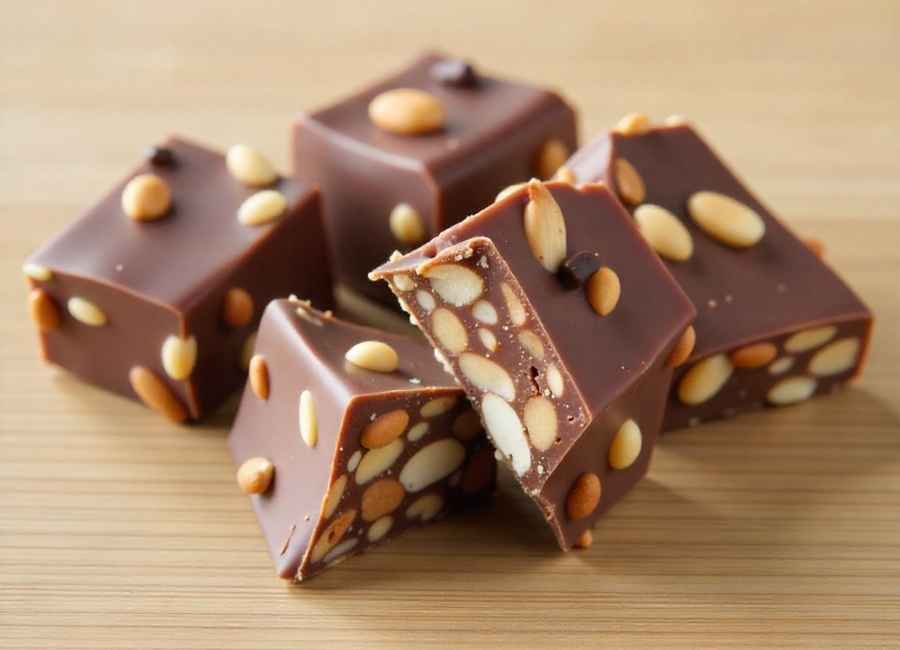Imagine you’re at the grocery store and suddenly decide to make chocolate-covered strawberries. You pick up some fresh berries and head to the baking aisle, only to find a huge variety of chocolate options. As you look over the white, milk, and dark chocolate bars, you notice something else—almond bark. It looks like chocolate, but is it really the same?
Chocolate and almond bark can be used in similar ways and are sometimes swapped in recipes, but their ingredients and how they’re made set them apart. Both work well for dipping treats like strawberries, pretzels, or graham crackers, and they’re often used as the base for homemade candy bars or seasonal treats like peppermint bark. Still, knowing the difference matters, especially if you want a certain taste, texture, or result in your recipes.
In this post, we’ll explain how chocolate and almond bark differ, what they’re made of, how they’re used, and which one might work better for your candy-making projects.
What is Almond Bark?

Even though it’s called almond bark, it doesn’t have any almonds in it. Instead, it’s a type of candy coating made from fats and sugar to look and feel like chocolate. Almond bark comes in flavors like chocolate or vanilla and is usually sold in big bars with indents, much like regular chocolate bars. (Chocolate Bark Assortment, n.d.)
A big advantage of almond bark is how easy it is to use. Chocolate often needs tempering, which is a careful process to get a shiny, smooth finish when melted. (Art of Chocolate Tempering: A Guide to Achieving a Perfect Gloss, n.d.) Almond bark skips this step and can be melted right in the microwave, making it a quick and convenient choice for dipping strawberries, pretzels, or making candy bars. (Vanilla Almond Bark 20oz – Favorite Day™, n.d.)
Does Almond Bark Really Taste Like Chocolate?
Here’s where it gets a bit confusing. Almond bark may look like chocolate, but it doesn’t always taste the same. Chocolate-flavored almond bark has cocoa powder and a mild chocolate taste, but it doesn’t meet the FDA’s definition of real chocolate. (Labeling of Products Purporting to be “Chocolate” or “Chocolate Flavored”, 1988) Real chocolate has cocoa butter and cocoa solids, while chocolate-flavored almond bark uses processed cocoa powder and other added flavors. (Almond bark, n.d.)
So, even though chocolate-flavored almond bark can give you a chocolate-like taste, it isn’t considered real chocolate. Still, it’s a handy and budget-friendly choice if you want to make chocolate-flavored treats without worrying about tempering.
What is Chocolate?

Unlike almond bark, chocolate is made from cocoa beans harvested from cacao trees. (Almond bark, n.d.) The beans are processed to extract cocoa butter and cocoa powder, which are then combined to make a variety of chocolate products, from bars to chips. (Broma process, n.d.) The three main types of chocolate—milk, dark, and white—differ in their proportions of cocoa butter, cocoa powder, and other ingredients like milk and sugar. (Types of Chocolate: Milk, Dark, White, 2024)
When baking with chocolate, it’s important to understand the different varieties and how thWhen you bake with chocolate, it helps to know the various types and how they affect your recipe. Semisweet or bittersweet chocolate is usually best for baking because it balances sweetness and richness. Milk and dark chocolate are also used in many desserts, depending on what you like—a smooth, rich texture. If you’re making a recipe that relies heavily on the chocolate flavor (like chocolate cake, mousse, or chocolate chip cookies), real chocolate is your best bet. However, if you’re looking for something easier to melt and dip without worrying about tempering, almond bark can be a good substitute.
Almond Bark and Chocolate Bark Confections

Now that you know the differences between chocolate, almond bark, and chocolate-flavored almond bark, let’s look at another treat you might see: almond bark and chocolate bark confections. Even though they share names with the candy coatings, these are different candies you’ll often find in specialty shops or the snack aisle.
Almond Bark Confection
Almond bark confection is a candy made with real chocolate and almonds, not the candy coating we discussed earlier. It’s easy to make: melt your favorite chocolate (milk, white, or dark), mix in almonds, spread it out thick, and let it cool in the fridge. You’ll get a crunchy, nutty treat with rich chocolate flavor.
You can also use chocolate-flavored almond bark for making almond bark confections, although the chocolate taste will be less pronounced. If you only have vanilla-flavored almond bark, that works too! The result will be a sweet, vanilla-flavored treat with a lovely crisp texture from the almonds.
Chocolate Bark Confection
Chocolate bark is similar, but you can customize it even more. Start with melted chocolate and add your favorite mix-ins, like nuts, dried fruit, or pretzels. Peppermint bark, made with chocolate and crushed peppermint candies, is a holiday favorite. You can get creative and make all kinds of chocolate bark combinations.
Which Should You Choose: Chocolate or Almond Bark?
So, what’s the takeaway? Choosing between chocolate and almond bark depends on what you need for your recipe:
- Use chocolate if you’re looking for authentic chocolate flavor in your recipes and are okay with taking the time to temper it (if needed).
- Use almond bark if you need something quick and easy that melts without any fuss. It’s perfect for dipping, candy-making, and coating treats, especially when you’re not too concerned about having real chocolate.
In the end, both options have their place in the kitchen, and both chocolate and almond bark have their uses in the kitchen, so it’s about finding what works best for your recipe. Whether you’re making homemade chocolate bars or dipping strawberries for dessert, understanding the difference helps you pick the right one for your treats. Happy cooking!


















